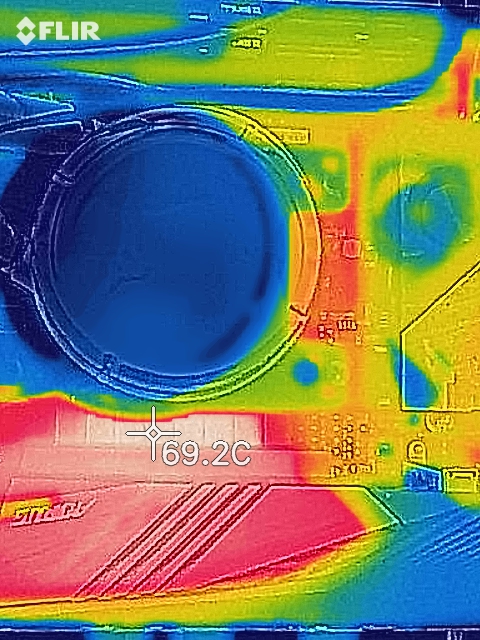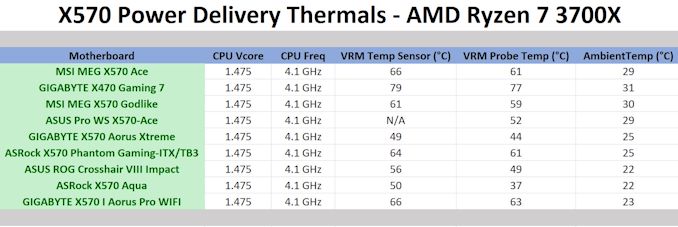On The Wings of an Eagle: GIGABYTE's X570 I Aorus Pro WIFI Motherboard Tested
by Gavin Bonshor on March 19, 2020 10:00 AM ESTPower Delivery Thermal Analysis
One of the most requested elements of our motherboard reviews revolves around the power delivery and its componentry. Aside from the quality of the components and its capability for overclocking to push out higher clock speeds which in turn improves performance, is the thermal capability of the cooling solutions implemented by manufacturers. While almost always fine for users running processors at default settings, the cooling capability of the VRMs isn't something that users should worry too much about, but for those looking to squeeze out extra performance from the CPU via overclocking, this puts extra pressure on the power delivery and in turn, generates extra heat. This is why more premium models often include heatsinks on its models with better cooling designs, heftier chunks of metal, and in some cases, even with water blocks.

The 6+2 power delivery on the GIGABYTE X570 I Aorus Pro WIFI motherboard
Testing Methodology
Out method of testing out if the power delivery and its heatsink are effective at dissipating heat, is by running an intensely heavy CPU workload for a prolonged method of time. We apply an overclock which is deemed safe and at the maximum that the silicon on our AMD Ryzen 7 3700X processor allows. We then run the Prime95 with AVX2 enabled under a torture test for an hour at the maximum stable overclock we can which puts insane pressure on the processor. We collect our data via three different methods which include the following:
- Taking a thermal image from a birds-eye view after an hour with a Flir Pro thermal imaging camera
- Securing three probes on to the rear of the PCB, right underneath CPU VCore section of the power delivery for better parity in case a probe reports a faulty reading
- Taking a reading of the VRM temperature from the sensor reading within the HWInfo monitoring application
The reason for using three different methods is that some sensors can read inaccurate temperatures, which can give very erratic results for users looking to gauge whether an overclock is too much pressure for the power delivery handle. With using a probe on the rear, it can also show the efficiency of the power stages and heatsinks as a wide margin between the probe and sensor temperature can show that the heatsink is dissipating heat and that the design is working, or that the internal sensor is massively wrong. To ensure our probe was accurate before testing, I binned 10 and selected the most accurate (within 1c of the actual temperature) for better parity in our testing.
For thermal image, we use a Flir One camera as it gives a good indication of where the heat is generated around the socket area, as some designs use different configurations and an evenly spread power delivery with good components will usually generate less heat. Manufacturers who use inefficient heatsinks and cheap out on power delivery components should run hotter than those who have invested. Of course, a $700 flagship motherboard is likely to outperform a cheaper $100 model under the same testing conditions, but it is still worth testing to see which vendors are doing things correctly.
Thermal Analysis Results

We measured 69.2°C on the hottest part of the board during our testing.
The hottest part of the heatsink was the MOSFETs
The GIGABYTE X570 I Aorus Pro WIFI is using a 6-phase power delivery for the processor with six Infineon TDA21472 70 A power stages and is controlled by an Infineon IR35201 PWM controller operating at 6+2. Cooling the board's power delivery is a small but capable heatsink which slots into the rear panel cover.
After running our VRM thermal tests, the GIGABYTE X570 I Aorus Pro WIFI performed well given the boards size in comparison to the boards we've previously tested. We observed temperatures of 66°C from the boards integrated thermal sensor, with our probes measuring 63°C attached to the rear of the power delivery. Our thermal imaging camera noted that the hottest part of the power delivery looking at the top of the board came from the MOSFETs, which we observed at just over 69°C. All our testing was done with our Ryzen 7 3700X processor and we expect the Ryzen 9 3950X processor to push the power delivery even further, and we wouldn't recommend using an overclocked 3950X in a system with this board without ensuring adequate airflow. This is due to the design of the heatsink which relies more on chassis with good airflow as opposed to a heatsink with a large mass.











63 Comments
View All Comments
SSTANIC - Thursday, March 19, 2020 - link
for X670 GIGABYTE could do: 1. lose all video out 2. double USB inputs 3. double fan connectors 4. real fins on VRMs 5. keep the price because noone will buy this for 300$ and maybe 6. who needs WIFI really? 7. another LAN portdanturbo316 - Friday, March 20, 2020 - link
The video out will be worth it with next gen apus, but right now I agree that it's a waste as the 3400g is a weaklingeek2121 - Friday, March 20, 2020 - link
Just because you don’t have a use case for it doesn’t mean others don’t. ITX is a relatively popular form factor. Not everyone is a gamer, and of those who are, some want to use GPU passthrough for gaming on Linux and other virtualization scenarios.Check out cases like the DanPC case or the louqe ghost s1.
jospoortvliet - Sunday, March 22, 2020 - link
I get that but if you want to run a cheap APU why on earth would you buy a x570 motherboard??? I understand using one video out just in case but 3 does seem like a waste for a high en board that people most likely will use with a high end cpu and GPU...spikebike - Thursday, March 19, 2020 - link
Yes another motherboard with a fan. Testing on similar motherboards show there's not much heat to dissipate. Why is there only one very expensive motherboard without a fan? I'm hoping B550 motherboards fix this.Marlin1975 - Thursday, March 19, 2020 - link
The B550 boards will not need a fan as they do not support PCIe 4.0 on the B550 chipset.The B550 looks like it will support PCIe 4.0 from the CPU to video card and M.2 port. But that is all.
InTheMidstOfTheInBeforeCrowd - Friday, March 20, 2020 - link
No. It has to be more. Like the chipset offering PCIe 3.0 lanes. Just the requirement of the motherboard having PCIe 4.0 slots tied to the CPU is not enough. AMD could have done that with the B450 months ago(!) with little hassle. Basically the B550A play.If after so many months, AMD would release a B550 that is merely a rebranded B450 with the added requirement that motherboard manufacturers support the PCIe 4.0 lanes of the CPU (basically the same as the B550A rebrand), then AMD is basically presenting itself to the world as an incompetent and inept clown posse. I don't think they are that dumb, though...
a5cent - Friday, March 20, 2020 - link
Ehm... Wat? B550 will not support PCIe 4.0, but that doesn't mean it's just a rebranding of B450!B450 is PCIe 2.0, not PCIe 3.0. Just supporting PCIe 3.0 is already a huge upgrade in itself. More importantly, B450 has a ridiculously low number of PCIe lanes, forcing motherboard makers to jump through all sorts of performance reducing hoops if they want to support even just a second M.2 drive. B550 is expected to support the same number of lanes as X570, so that too is a very significant upgrade. Lastly, not requiring the chipset to be actively cooled is also an improvement. Sacrificing PCIe 4.0 in order to ditch the fan is a very reasonable trade-off to make, as almost nobody will notice the difference between PCIe 4.0 and 3.0 coming off the chipset anyway.
B450 was hopelessly outdated last year already. It is a bargain bin chipset, as it was itself a rebranding of B350. B550 is not like that at all.
InTheMidstOfTheInBeforeCrowd - Friday, March 20, 2020 - link
Erm ... i never said that B550 will be a rebranded B450. I was saying "If...", addressing the implication made in the comment above mine that B550 will only bring support for the CPU PCIe 4.0 lanes to the table (which essentially is the same as implying that B550 would be merely a rebrand of B450)a5cent - Friday, March 20, 2020 - link
Yeah, sorry, I misread your comment. The comment you responded to is so ridiculous that it didn't register in my brain the way it was written.It seems a lot of people here don't understand that the CHIPSET is a separate thing that has no bearing on the PCIe lanes coming off the CPU. The traces between the CPU and the GPU on B450 motherboards were simply never validated for PCIe 4.0 (resistance, signal reflections, etc), so they deactivated PCIe 4.0 in firmware to protect the motherboard manufacturers from warranty claims. I guess some people's imaginations associated that downgrade to the chipset, which really has nothing to do with it.